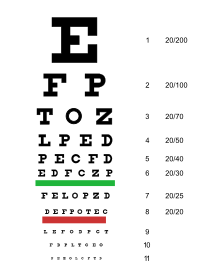Herman Snellen
Herman Snellen | |
|---|---|
 | |
| Born | 19 February 1834 |
| Died | 18 January 1908 (aged 73) |
| Nationality | Dutch |
| Known for | Snellen chart |
| Scientific career | |
| Fields | ophthalmology |
| Institutions | Netherlands Hospital for Eye Patients |

Herman Snellen (February 19, 1834 – January 18, 1908) was a Dutch
Early life
Herman Snellen studied medicine at Utrecht University under Donders, Gerardus Johannes Mulder and Jacobus Schroeder van der Kolk. He earned his medical degree in 1858 from Leiden University. He specialized in ophthalmology and worked as an assistant physician at the Netherlands Hospital for Eye Patients after he had completed his degree.
Director
He was named to succeed Donders as the institute's director in 1884, a position he served until 1903. In 1877, he was appointed as a professor of ophthalmology at Utrecht University. He did research on astigmatism, glaucoma and other eye diseases as well as research on correction of visual acuity using eyeglasses and ophthalmological surgery.[2]
Chart
Although alternative versions had been developed before him, by Eduard Jäger von Jaxtthal and others, in 1862 Snellen developed his eye chart to measure visual acuity.[3]
The first edition of Snellen's book was in German. Over more than two deades, he published at least seven more editions of his book. The eighth edition contains charts in English, Italian, French, German, and a calligraphic hand of the Latin script of German.[4] Snellen's charts became the global standard.[5]
The most significant innovation was Snellen's use of what he called
Since its inception, more copies of the Snellen Chart have been sold in the United States than any other poster. It remained a ubiquitous standard in medical offices into the 21st century.[6]
References
- ^ "APS Member History". search.amphilsoc.org. Retrieved 2024-03-28.
- ^ Herman Snellen, Whonamedit.com. Accessed July 6, 2010.
- ^ Snellen, Herman (1862). Probebuchstaben zur Bestimmung der Sehschärfe [Test letters for measuring visual acuity. Utrecht: P. W. Van De Weijer. Retrieved 12 September 2023.
- ^ Snellen, Herman (1885). Optotypi ad visum determinandum secundum formulam = d/D. Ed. 8, metrico systemate (8 ed.). London: Williams and Norgate. Retrieved 12 September 2023.
- ^ Watt, Wendy Strouse. "How Visual Acuity Is Measured" Archived 2020-06-19 at the Wayback Machine, Macular Degeneration Support, October 2003. Accessed July 6, 2010.
- ^ Bordsen, John. "Eye Chart Still The Standard For Vision", The Seattle Times, August 9, 1995. Accessed July 6, 2010.
